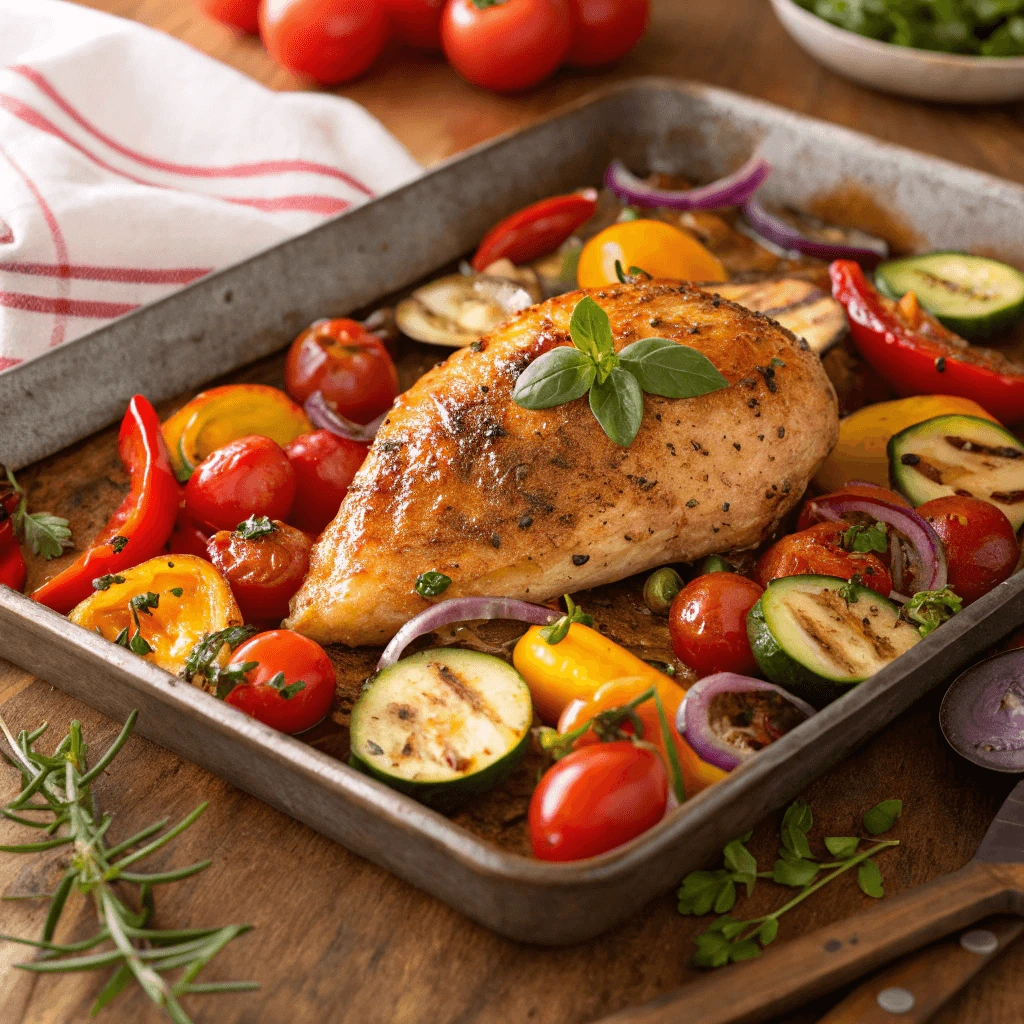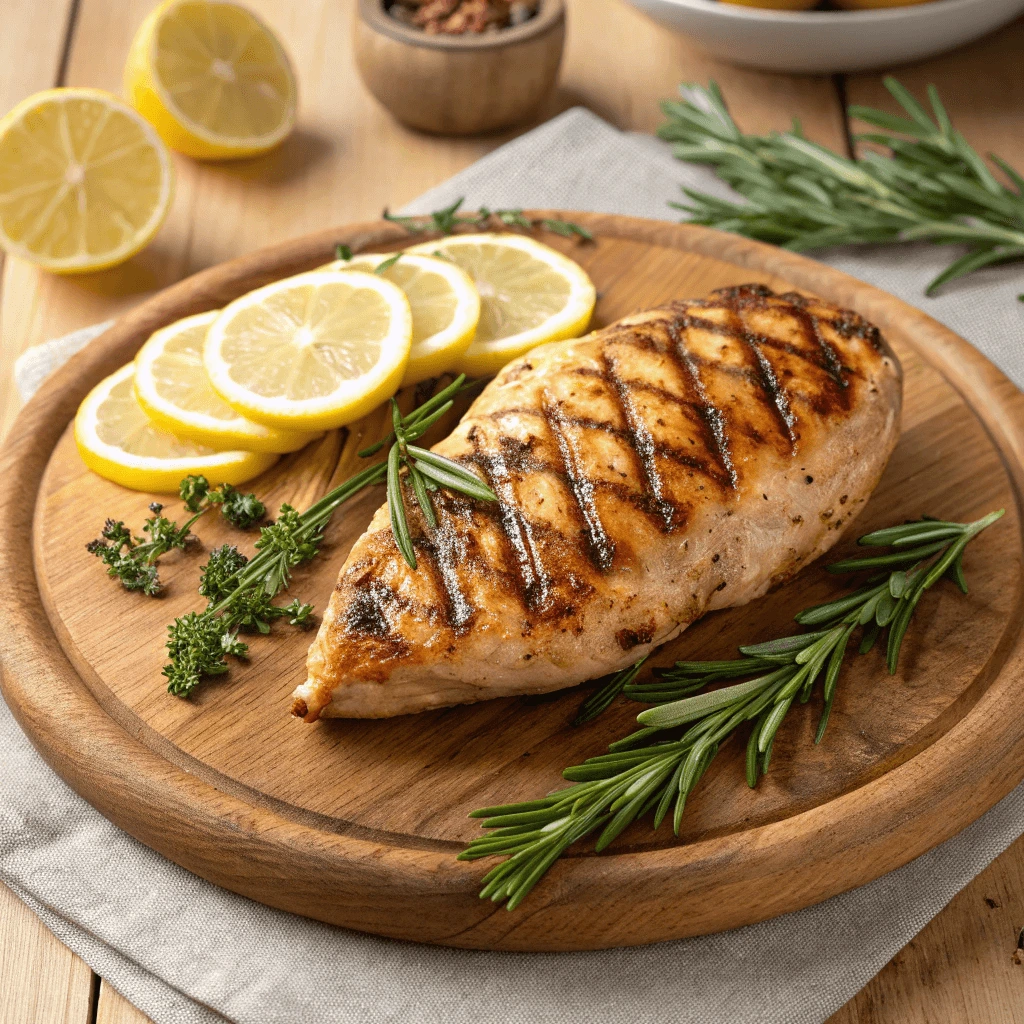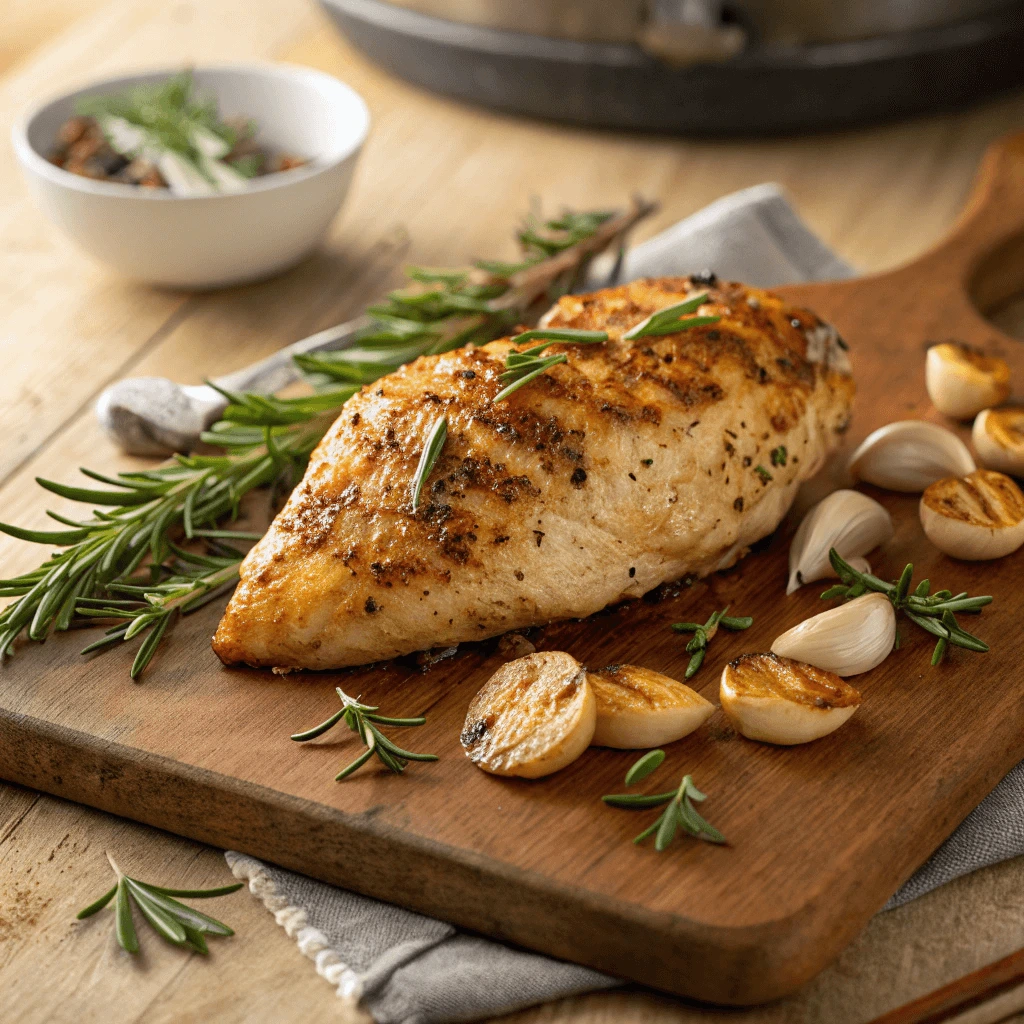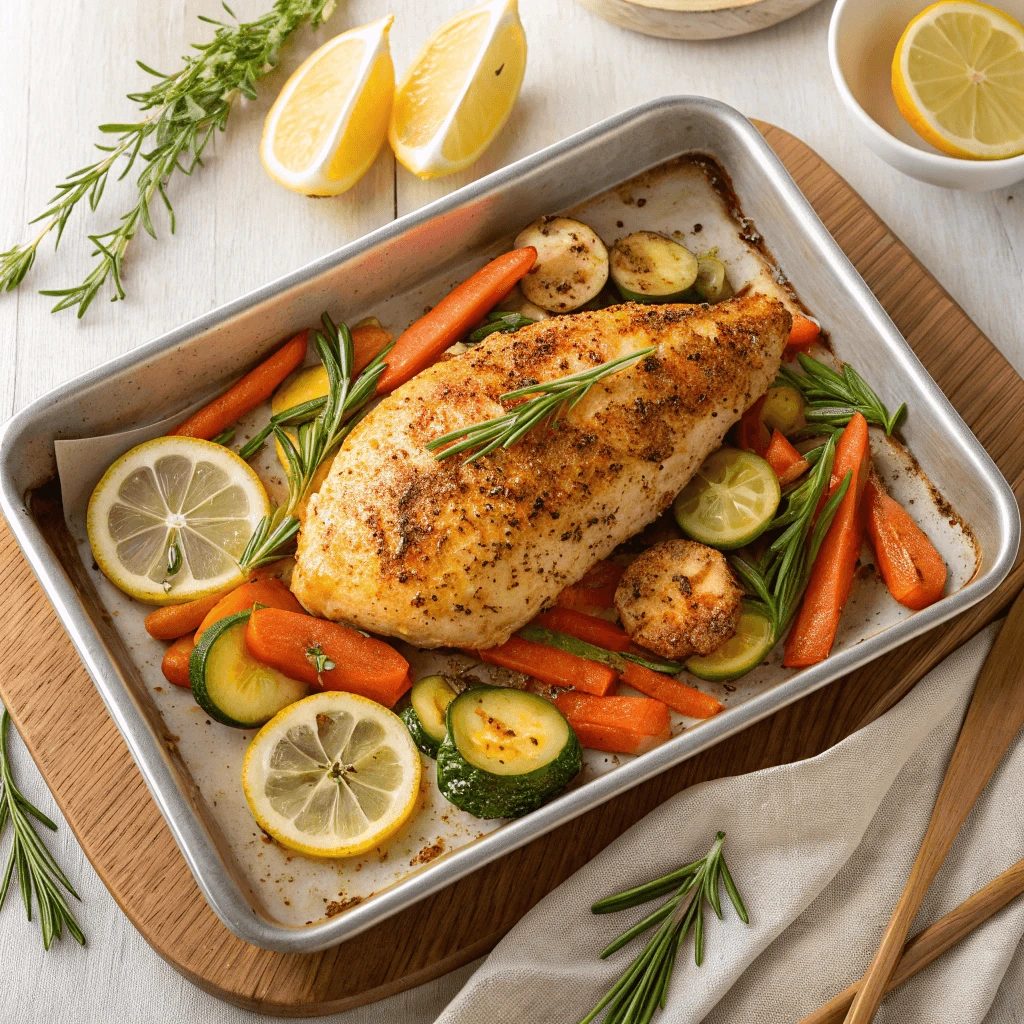Looking for quick, healthy, and delicious meals? These juicy chicken breast recipes are your answer! Whether you’re short on time or just want a flavorful dinner without the fuss, these dishes come together in under 30 minutes. Packed with lean protein and easy to customize, chicken breast is a weeknight hero in any kitchen. From pan-seared perfection to oven-baked favorites, we’ll show you how to cook chicken breast that’s never dry or bland. Get ready for simple, satisfying recipes your whole family will love!
Why Chicken Breast Is a Quick and Healthy Dinner Option

The Nutritional Benefits of Chicken Breast
Lean Protein That Fuels Your Body
Chicken breast is one of the best sources of lean protein. A 3.5-ounce (100g) cooked, skinless chicken breast contains about 31 grams of protein and only 165 calories. This high protein-to-calorie ratio helps you feel full longer, supports muscle growth, and aids in weight loss.
Low in Fat, High in Nutrients
Unlike other cuts of meat, chicken breast is naturally low in saturated fat. It also delivers essential nutrients like vitamin B6, niacin, phosphorus, and selenium—all of which help support metabolism, energy production, and immune function. Choosing boneless, skinless chicken breast allows you to enjoy a filling meal without unnecessary fats.
Great for Special Diets and Meal Plans
Whether you’re following a low-carb, high-protein, keto, or calorie-controlled diet, chicken breast fits right in. It’s a staple in many meal prep plans thanks to its versatility and nutrition profile. You can bake, grill, sauté, or air-fry it, and it still delivers excellent health benefits.
Adding chicken breast to your meals is a simple and effective way to improve your overall nutrition while keeping your meals quick, flavorful, and satisfying.
Why It’s Ideal for 30-Minute Meals
Cooks Fast with Minimal Prep
Chicken breast is naturally lean and boneless, which means it cooks much faster than many other proteins. You don’t need hours to tenderize or marinate it—just a few ingredients and about 15 minutes on the stove or in the oven. Because of its thin, uniform shape, it reaches a safe internal temperature (165°F or 74°C) quickly.
Pairs Well with Quick Ingredients
This cut of chicken pairs easily with pantry staples like olive oil, garlic powder, lemon juice, or paprika. You can toss it with frozen vegetables, pre-cooked grains, or simple sauces for a complete, balanced meal. Whether you sauté it in a skillet or roast it on a sheet pan, the total cooking time stays under 30 minutes.
Perfect for Weeknights and Meal Prep
Busy schedules don’t leave much room for long cooking sessions. Chicken breast solves that problem with reliable, quick results. It stores well, reheats evenly, and keeps its flavor for days—making it a great option for meal prepping. With a few smart seasonings, you can create multiple easy dinners with minimal effort.
Common Mistakes That Make Chicken Dry
Overcooking Without Monitoring Internal Temperature
Many home cooks overcook chicken breast out of fear it’s underdone. Unfortunately, this leads to dry, rubbery meat. Use an instant-read thermometer and remove the chicken from heat as soon as it reaches 165°F (74°C). That’s the safe temperature—no need to go higher.
Skipping the Resting Period
Slicing chicken breast immediately after cooking allows juices to escape. This mistake leaves the meat dry and less flavorful. Instead, let it rest for 5 to 10 minutes after cooking. This helps the juices redistribute evenly, keeping the chicken moist and tender.
Using No Marinade or Moisture-Rich Ingredients
Cooking plain, unseasoned chicken breast can result in a bland and dry meal. Marinades with olive oil, lemon juice, or yogurt add flavor and help retain moisture during cooking. Even a quick 15-minute soak improves texture and taste.
Cooking Straight from the Fridge
Placing cold chicken breast directly in a hot pan can cook it unevenly. The outside may dry out before the center is fully cooked. Let your chicken sit at room temperature for 15–20 minutes before cooking to ensure even doneness.
How to Cook Chicken Breast Perfectly Every Time
Best Cooking Methods for Juicy Chicken
Cooking chicken breast to stay juicy is easier than you think—if you choose the right method and follow a few key techniques. Here are the most reliable ways to get flavorful, tender results every time.
Pan-Searing for a Crispy Outside and Moist Center
Pan-searing is one of the quickest and most flavorful ways to cook chicken breast. Heat a cast iron or non-stick skillet over medium-high heat, add olive oil, and sear the chicken for 5–7 minutes per side. Let it rest before slicing. The hot pan forms a golden crust while locking in the juices.
Oven-Baking for Even Cooking
Baking chicken breast at 400°F (200°C) allows for even cooking without much attention. To avoid drying it out, cover it with foil or bake in a marinade or sauce. A simple mix of garlic powder, paprika, olive oil, and lemon juice adds great flavor and keeps the meat moist.
Grilling for Smoky, Charred Flavor
Grilling gives chicken breast a delicious smoky flavor. To prevent dryness, marinate the meat beforehand and grill over medium heat for 6–8 minutes per side. Always use a meat thermometer to ensure it’s cooked to 165°F (74°C) but not overdone.
Air Frying for Speed and Crispiness
If you’re short on time, the air fryer is a great tool. Preheat it to 375°F (190°C), season the chicken, and cook for 10–12 minutes, flipping halfway through. You’ll get juicy chicken with a crisp outer layer and minimal cleanup.
No matter which method you choose, always let the chicken rest before cutting to retain its moisture.
The Ideal Internal Temperature (165°F / 74°C)
Cooking chicken breast to the right internal temperature is the key to juicy, safe results. When you hit 165°F (74°C), you strike the perfect balance between flavor, texture, and food safety.
Why 165°F Is the Magic Number
Chicken must reach 165°F to kill harmful bacteria like Salmonella. This temperature ensures the meat is safe to eat without becoming dry or rubbery. While other proteins like beef can be eaten at medium or medium-rare, poultry always requires full cooking to this standard.
Avoid Overcooking by Monitoring Closely
Many people overcook chicken breast “just to be sure.” Unfortunately, that approach leads to a dry, chewy result. The better method is to monitor the temperature with a reliable meat thermometer. Insert it into the thickest part of the breast—avoid touching bone or the pan.
Use an Instant-Read Thermometer for Accuracy
An instant-read digital thermometer gives fast and accurate readings. Check the temperature as the chicken nears the end of its cooking time. If it reads 160°F, remove it from heat and let it rest. The temperature will continue to rise to 165°F as it rests.
Let It Rest for Maximum Juiciness
Resting the chicken breast after cooking helps the juices settle back into the meat. Cut it too soon, and those flavorful juices spill out onto the cutting board instead of staying in each bite. Let it rest 5–10 minutes before slicing.
Cooking to the ideal internal temperature doesn’t just keep you safe—it guarantees a moist and delicious chicken breast every time.
Resting Time: The Secret to Moist Chicken
Resting chicken breast after cooking is one of the simplest but most overlooked steps to ensure juicy, tender meat. Many cooks rush to slice immediately, which causes the flavorful juices to escape, leaving dry chicken behind. Understanding why resting matters will help you serve restaurant-quality chicken every time.
What Happens When You Rest Chicken Breast
During cooking, heat pushes the juices inside the meat toward the surface. If you cut into the chicken right away, these concentrated juices spill out onto your cutting board. Letting the chicken rest allows the juices to redistribute evenly throughout the meat fibers. This process results in every bite being juicy, tender, and full of flavor.
How Long Should You Rest Chicken?
For a typical chicken breast, resting for 5 to 10 minutes works best. Cover the chicken loosely with foil to keep it warm without causing steam, which could soften the crispy exterior. Avoid skipping resting time, especially with lean cuts like chicken breast that dry out easily.
Resting Techniques for Best Results
Place cooked chicken breast on a warm plate or cutting board and tent it with aluminum foil. The foil traps heat but lets moisture escape, so the skin or crust remains crisp. If you’re cooking multiple breasts, rest them all together to maintain temperature.
Resting Benefits Beyond Moisture
Resting also improves texture and makes slicing easier. The meat firms up slightly, allowing for cleaner, more uniform cuts. This technique is essential for meal prep or plated dishes where presentation matters.
Flavorful Chicken Breast Marinades and Seasonings

3-Ingredient Chicken Marinade Ideas
Using just three ingredients, you can easily make flavorful marinades that keep chicken breast juicy and tasty. These quick marinades are perfect for busy days and simple meal prep.
Olive Oil, Lemon Juice, and Garlic
A classic combo that adds moisture and bright flavor. Mix olive oil, fresh lemon juice, and minced garlic. Marinate chicken breast for at least 15 minutes for best results.
Soy Sauce, Honey, and Ginger
This sweet and savory blend gives your chicken an Asian-inspired twist. Combine soy sauce, honey, and grated ginger. Let the chicken soak for 20–30 minutes before cooking.
Yogurt, Paprika, and Cumin
Yogurt tenderizes while paprika and cumin add smoky warmth. Mix plain yogurt with these spices and marinate the chicken for 30 minutes or longer for extra tenderness.
Quick Marinade Tips
Use a sealed bag or container for even coating. Even short marinades improve flavor. Avoid marinating in acidic mixtures too long to prevent toughening.
These easy marinades are a simple way to boost flavor and keep chicken breast juicy without fuss.
Must-Have Herbs and Spices
Using the right herbs and spices can turn plain chicken breast into a flavorful meal. These staples add depth without extra calories or effort.
Fresh vs. Dried Herbs
Fresh herbs like rosemary and thyme offer bright flavors and aroma, perfect for roasting or grilling chicken breast. Dried herbs are more concentrated and convenient for quick seasoning—use less when substituting.
Top Herbs for Chicken Breast
Rosemary pairs well with roasted chicken, thyme adds earthy notes, oregano brings a Mediterranean touch, and parsley provides a fresh finish.
Essential Spices to Boost Flavor
Paprika adds mild sweetness and color, garlic powder gives savory warmth, cumin lends earthiness, and black pepper adds a gentle kick.
Combining these herbs and spices in marinades or rubs can make your chicken breast dishes more exciting and delicious with minimal effort.
Quick Tips for Maximum Flavor in Juicy Chicken Breast Recipes
You don’t need hours to make chicken breast taste amazing. These simple tips help you boost flavor quickly without drying out the meat.
Use Acidic Marinades
Lemon juice, vinegar, or yogurt tenderize chicken breast fast and add bright, tangy flavor. Even 15 minutes makes a difference.
Massage in Seasonings
Rubbing marinades or spices into the chicken helps flavors soak in deeper than just sprinkling on top.
Pick Bold Spices
Strong flavors like smoked paprika, garlic powder, and cumin add a lot of taste quickly, perfect for speedy meals.
Cook on Medium-High Heat
This lets the outside brown nicely while keeping the inside juicy. Flip once for even cooking.
Let It Rest
Rest chicken breast for 5–10 minutes after cooking so juices redistribute and the meat stays moist.
Add Quick Sauces
Brush on honey mustard or soy sauce glazes right before serving to boost flavor instantly.
30-Minute Juicy Chicken Breast Recipes You’ll Love

Pan-Seared Garlic Herb Juicy Chicken Breast Recipes
Pan-searing chicken breast is a quick way to get juicy, flavorful results. The garlic and herbs add a delicious boost that’s perfect for any weeknight.
Prepare the Chicken
Pat the chicken breast dry and season with salt, pepper, and garlic powder. This helps create a tasty crust.
Sear the Chicken
Heat olive oil in a skillet over medium-high heat. Cook the chicken for 5–7 minutes per side without moving it, so it browns nicely.
Add Garlic and Herbs
When flipping, add minced garlic and fresh herbs like thyme or parsley to the pan. Spoon the flavored oil over the chicken while cooking.
Rest and Serve
Check that the internal temperature reaches 165°F (74°C). Let the chicken rest for 5 minutes before slicing to keep it juicy.
Serve with veggies or your favorite sides for a simple, delicious meal.
Oven-Baked Lemon Pepper Juicy Chicken Breast Recipes
Oven-baked lemon pepper chicken breast is a simple, flavorful dish that’s both juicy and easy to prepare. This recipe combines zesty lemon with bold black pepper to create a bright and savory flavor profile perfect for weeknight dinners or meal prep.
Preparing the Chicken Breast
Start by patting the chicken breasts dry with paper towels. Drying the surface helps the seasoning stick better and promotes even browning during baking. Next, drizzle olive oil over the chicken breasts, rubbing it evenly on both sides. This helps keep the chicken moist and adds richness.
Seasoning with Lemon and Pepper
Sprinkle a generous amount of freshly ground black pepper and sea salt on both sides of the chicken breast. Then zest one lemon and evenly distribute the lemon zest over the chicken. The zest delivers concentrated citrus flavor without excess moisture. Squeeze fresh lemon juice over the top for tanginess. Optionally, add a pinch of garlic powder or dried herbs like thyme for extra aroma.
Baking to Perfection
Preheat your oven to 400°F (200°C). Arrange the seasoned chicken breasts on a baking sheet lined with parchment paper or lightly greased. Bake uncovered for about 20–25 minutes. To avoid overcooking and drying out the chicken breast, check the internal temperature with a meat thermometer. Remove the chicken once it reaches 165°F (74°C). Let the chicken rest for 5 minutes to allow juices to redistribute.
Serving Suggestions and Tips
Oven-baked lemon pepper chicken pairs wonderfully with steamed vegetables, roasted potatoes, or a fresh green salad. For extra flavor, spoon some pan juices or a quick lemon butter sauce over the chicken before serving.
One-Pan Juicy Chicken Breast Recipes with Veggies
One-pan meals are perfect for quick, easy dinners with minimal cleanup. This recipe combines juicy chicken breast and roasted veggies for a balanced meal.
Prep the Chicken and Veggies
Pat chicken breasts dry and season with salt, pepper, and herbs. Chop broccoli, carrots, and sweet potatoes into bite-sized pieces and toss with olive oil and seasoning.
Sear the Chicken
Heat oil in an oven-safe skillet. Sear chicken breasts 4 minutes per side until golden.
Combine and Bake
Add the veggies to the pan, nestle the chicken on top, and bake at 400°F (200°C) for 15–20 minutes until chicken reaches 165°F (74°C).
Serve and Enjoy
Let chicken rest before slicing. Serve with the roasted vegetables and pan juices for a tasty, fuss-free dinner.
Meal Prep and Storage Tips for Juicy Chicken Breast Recipes
How to Batch Cook Juicy Chicken Breast Recipes for the Week
Batch cooking chicken breast saves time and makes meal prep easier. Here’s how to do it efficiently.
Choose Your Cooking Method
Bake, grill, poach, or slow cook chicken breasts. Baking is hands-off, grilling adds flavor, and poaching keeps it moist.
Prep for Even Cooking
Trim fat, pat dry, and pound thicker breasts to even thickness. Season well for added flavor.
Cook and Rest
Cook until the internal temperature reaches 165°F (74°C). Let the chicken rest for 5 minutes to keep it juicy.
Store and Reheat
Divide into portions and store in airtight containers in the fridge (up to 4 days) or freezer (up to 3 months). Reheat gently to avoid drying out.
Batch cooking chicken breast means you have healthy, ready-to-eat protein all week with minimal effort.
Proper Storage for Juiciness and Safety
Properly storing cooked chicken breast ensures it stays juicy, flavorful, and safe to eat throughout the week. Following the right steps helps preserve texture and prevent bacterial growth.
Cooling Chicken Quickly and Safely
After cooking, allow the chicken breast to cool slightly at room temperature for no more than 2 hours. Then transfer it to the refrigerator promptly. Cooling chicken quickly reduces the risk of harmful bacteria multiplying. Avoid leaving chicken out longer than two hours, especially in warm environments.
Storing Chicken Breast in the Refrigerator
Place the cooked chicken breast in airtight containers or resealable bags to lock in moisture and prevent contamination. Store it on a middle or lower shelf where the temperature stays consistent. Consume refrigerated chicken breast within 3 to 4 days for optimal freshness and safety.
Freezing Chicken Breast for Longer Storage
For longer storage, freeze cooked chicken breast in airtight freezer-safe bags or containers. Remove as much air as possible before sealing to prevent freezer burn. Label each package with the date to keep track of storage time. Frozen chicken breast maintains best quality for up to 3 months but remains safe to eat beyond that if kept frozen consistently.
Thawing and Reheating Tips
Thaw frozen chicken breast safely by moving it to the refrigerator the night before you plan to use it. This slow thaw helps retain juiciness and texture. Avoid thawing at room temperature, which increases food safety risks. When reheating, use moderate heat and cover the chicken to keep moisture locked in. Adding a splash of broth or water before reheating can help maintain tenderness.
Reheating Juicy Chicken Breast Recipes Without Drying Out
Reheating chicken breast can be tricky—without the right technique, it often turns dry and tough. Using the proper methods helps maintain juiciness and flavor, so leftovers taste almost as good as freshly cooked.
Why Chicken Breast Dries Out When Reheated
Chicken breast is a lean cut, meaning it has less fat and connective tissue to retain moisture during reheating. When exposed to high heat or reheated for too long, the water inside evaporates quickly, causing the meat to become dry and rubbery. To avoid this, reheating requires gentle, controlled heat and techniques that preserve moisture.
Best Methods to Reheat Chicken Breast
Oven Reheating
Preheat your oven to 325°F (163°C). Place the chicken breast in an oven-safe dish and add a splash of chicken broth or water. Cover the dish with foil to trap steam, which helps keep the meat moist. Heat for 15-20 minutes or until warmed through, checking occasionally to avoid overcooking.
Microwave Reheating
Use a microwave-safe dish and cover the chicken with a microwave-safe lid or damp paper towel. Heat on medium power in 30-second intervals, flipping or stirring the chicken halfway through. This gradual warming reduces hot spots that dry out the meat.
Stovetop Reheating
Heat a small amount of olive oil or butter in a skillet over medium-low heat. Add the chicken breast and cover with a lid. Warm gently for about 5-8 minutes, flipping occasionally. Adding a splash of broth or water and covering the pan creates steam that keeps the chicken juicy.
Tips for Maintaining Juiciness
Avoid reheating chicken breast more than once, as repeated heating increases dryness. Let leftovers cool before refrigerating to reduce moisture loss. When reheating, always monitor closely to prevent overheating.
Conclusion
Cooking juicy chicken breast doesn’t have to be time-consuming or complicated. With the right techniques and simple ingredients, you can prepare delicious, tender meals in under 30 minutes. Whether you prefer pan-searing, baking, or grilling, these quick recipes ensure flavorful results every time. Incorporate fresh herbs, bold spices, and easy marinades to elevate your chicken dishes effortlessly. Try these fast and tasty chicken breast recipes to enjoy healthy, satisfying meals without the wait or stress.
